Deakin University SIT719 Assessment 2: Security and Privacy Report
VerifiedAdded on 2023/06/04
|14
|3749
|188
Report
AI Summary
This report examines the security and privacy issues faced by Dumnonia Corporation, an Australian insurance company, in handling sensitive customer data. It focuses on the implementation of k-anonymity as a method to protect data privacy, addressing cyber-security threats like ransomware and unauthorized access. The report outlines organizational drivers for deploying k-anonymity, analyzes technology solutions, and provides an implementation guide. It explores the advantages and limitations of k-anonymity, including re-identification risks and data loss, and discusses various techniques like generalization and suppression. The report also evaluates the costs associated with k-anonymity and its application in data sharing between organizations and governments, providing a comprehensive analysis of data security and privacy in the context of big data analytics. The report highlights the importance of balancing data utility and privacy, offering insights into mitigating security and privacy risks within the organization.
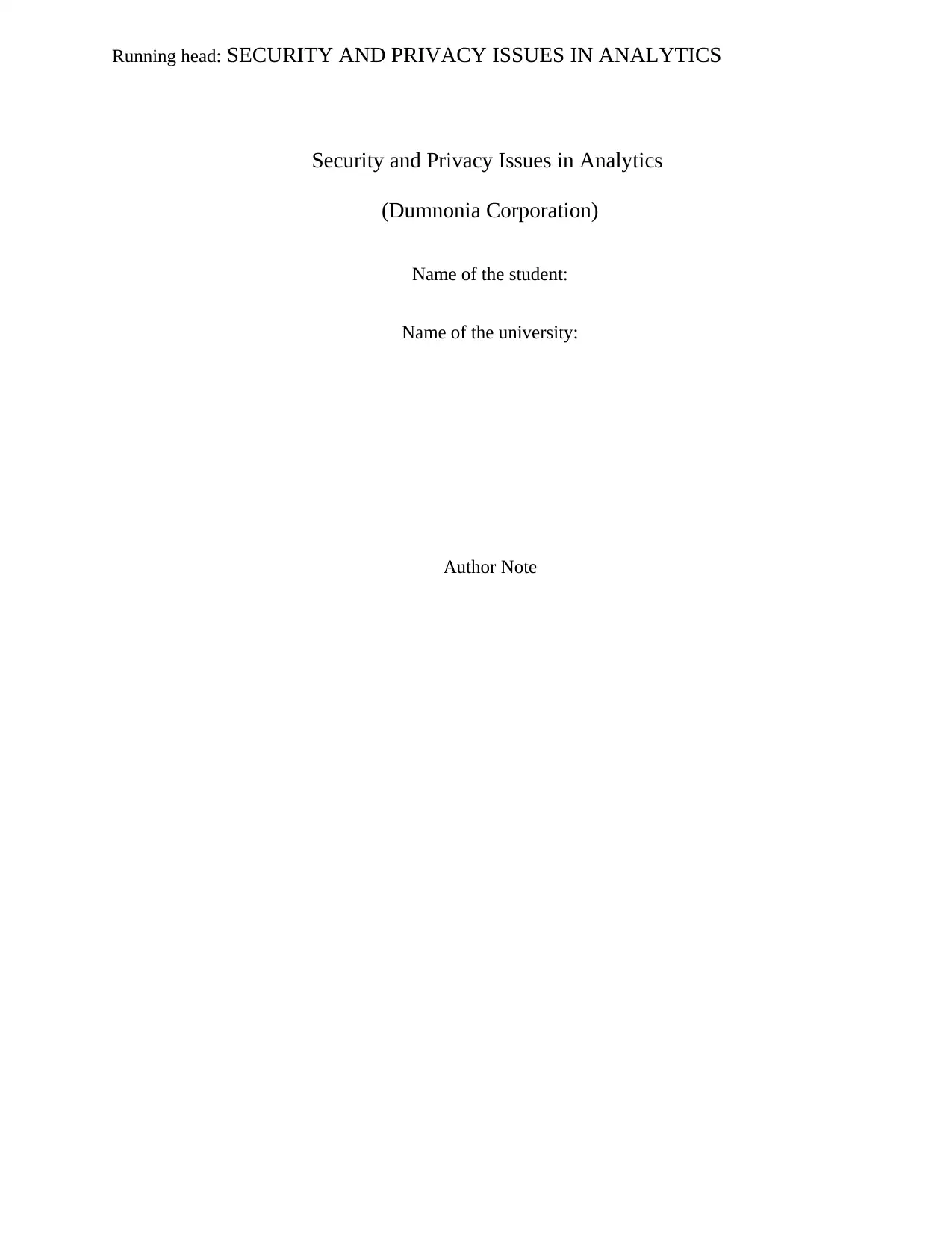
Running head: SECURITY AND PRIVACY ISSUES IN ANALYTICS
Security and Privacy Issues in Analytics
(Dumnonia Corporation)
Name of the student:
Name of the university:
Author Note
Security and Privacy Issues in Analytics
(Dumnonia Corporation)
Name of the student:
Name of the university:
Author Note
Paraphrase This Document
Need a fresh take? Get an instant paraphrase of this document with our AI Paraphraser
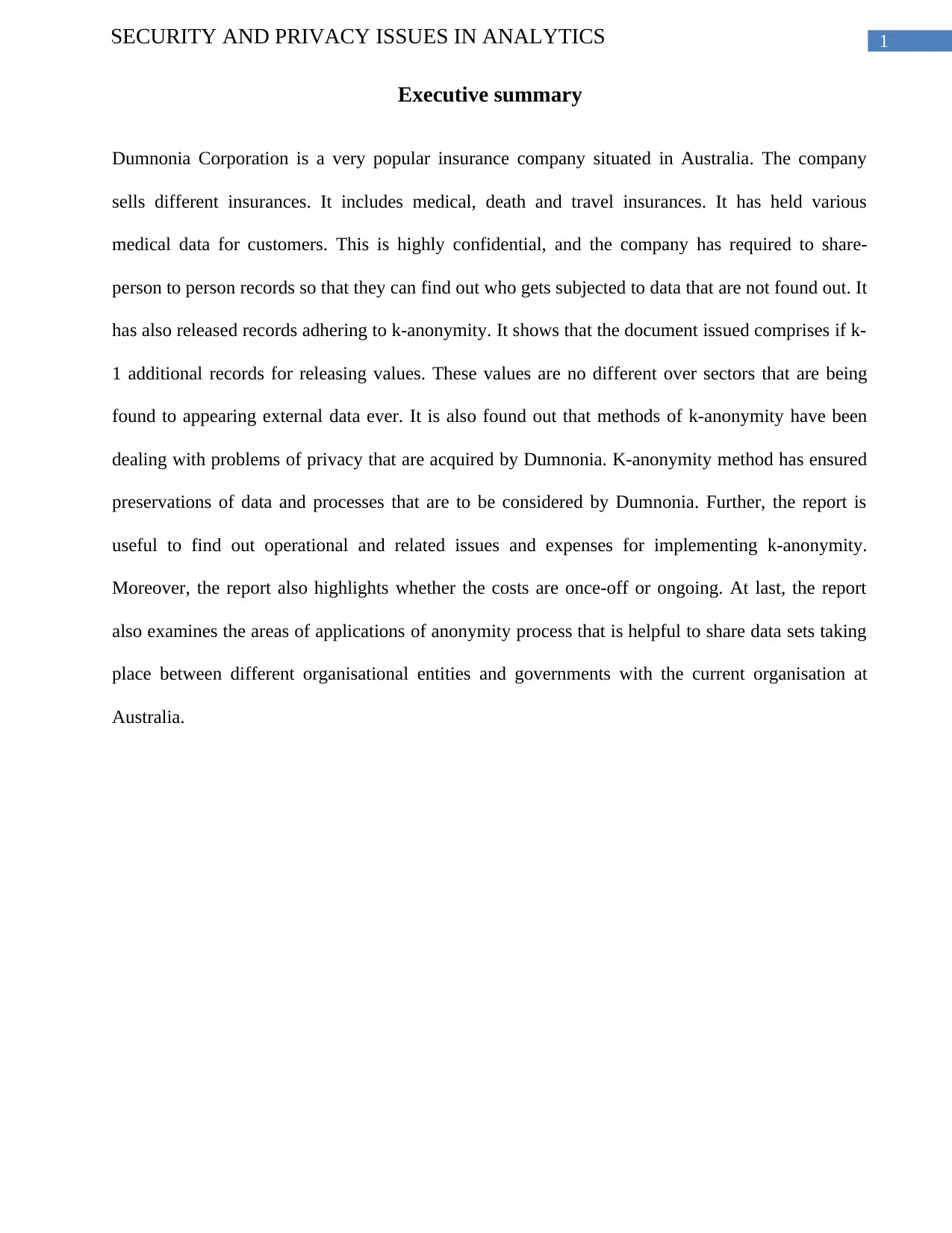
1SECURITY AND PRIVACY ISSUES IN ANALYTICS
Executive summary
Dumnonia Corporation is a very popular insurance company situated in Australia. The company
sells different insurances. It includes medical, death and travel insurances. It has held various
medical data for customers. This is highly confidential, and the company has required to share-
person to person records so that they can find out who gets subjected to data that are not found out. It
has also released records adhering to k-anonymity. It shows that the document issued comprises if k-
1 additional records for releasing values. These values are no different over sectors that are being
found to appearing external data ever. It is also found out that methods of k-anonymity have been
dealing with problems of privacy that are acquired by Dumnonia. K-anonymity method has ensured
preservations of data and processes that are to be considered by Dumnonia. Further, the report is
useful to find out operational and related issues and expenses for implementing k-anonymity.
Moreover, the report also highlights whether the costs are once-off or ongoing. At last, the report
also examines the areas of applications of anonymity process that is helpful to share data sets taking
place between different organisational entities and governments with the current organisation at
Australia.
Executive summary
Dumnonia Corporation is a very popular insurance company situated in Australia. The company
sells different insurances. It includes medical, death and travel insurances. It has held various
medical data for customers. This is highly confidential, and the company has required to share-
person to person records so that they can find out who gets subjected to data that are not found out. It
has also released records adhering to k-anonymity. It shows that the document issued comprises if k-
1 additional records for releasing values. These values are no different over sectors that are being
found to appearing external data ever. It is also found out that methods of k-anonymity have been
dealing with problems of privacy that are acquired by Dumnonia. K-anonymity method has ensured
preservations of data and processes that are to be considered by Dumnonia. Further, the report is
useful to find out operational and related issues and expenses for implementing k-anonymity.
Moreover, the report also highlights whether the costs are once-off or ongoing. At last, the report
also examines the areas of applications of anonymity process that is helpful to share data sets taking
place between different organisational entities and governments with the current organisation at
Australia.
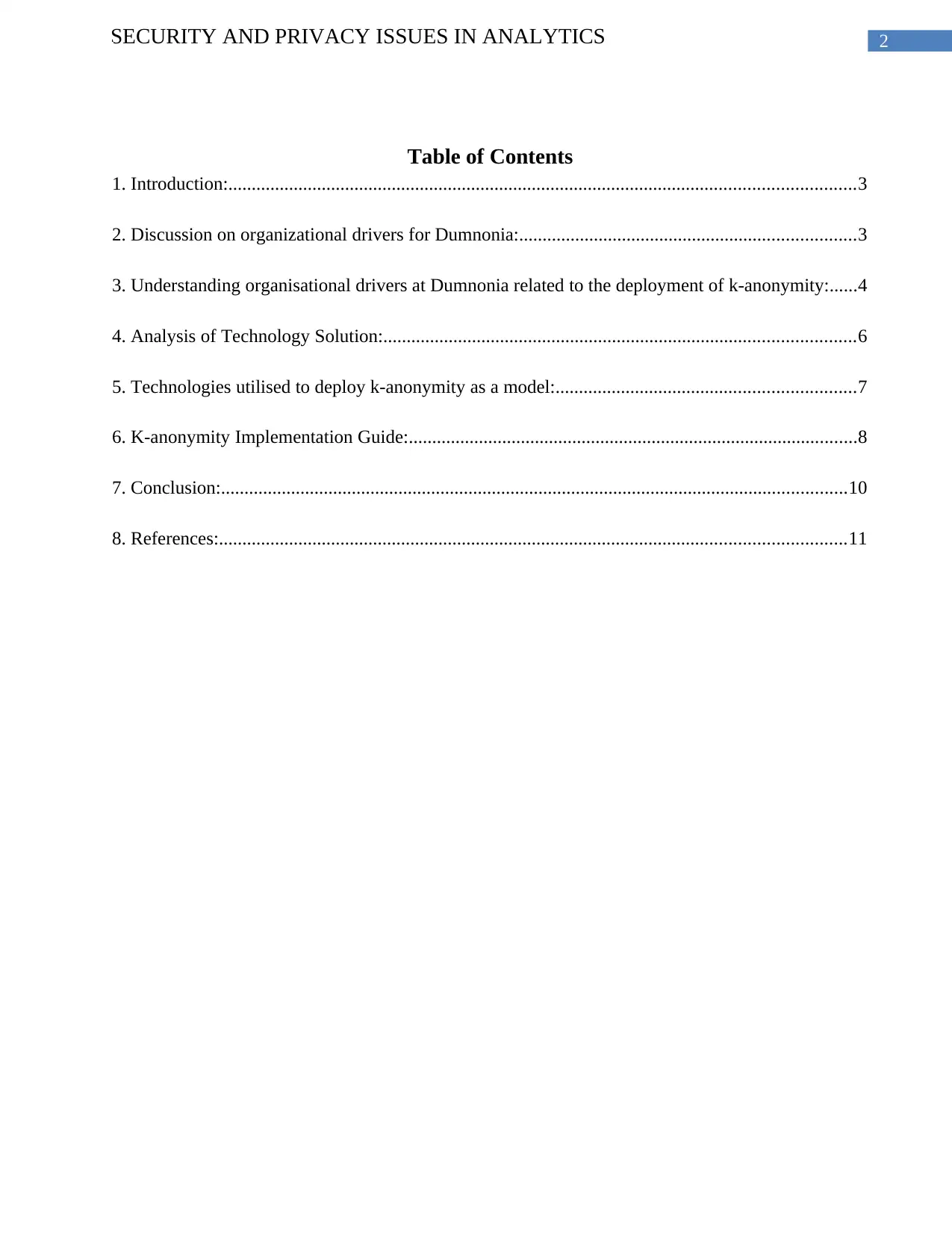
2SECURITY AND PRIVACY ISSUES IN ANALYTICS
Table of Contents
1. Introduction:......................................................................................................................................3
2. Discussion on organizational drivers for Dumnonia:........................................................................3
3. Understanding organisational drivers at Dumnonia related to the deployment of k-anonymity:......4
4. Analysis of Technology Solution:.....................................................................................................6
5. Technologies utilised to deploy k-anonymity as a model:................................................................7
6. K-anonymity Implementation Guide:................................................................................................8
7. Conclusion:......................................................................................................................................10
8. References:......................................................................................................................................11
Table of Contents
1. Introduction:......................................................................................................................................3
2. Discussion on organizational drivers for Dumnonia:........................................................................3
3. Understanding organisational drivers at Dumnonia related to the deployment of k-anonymity:......4
4. Analysis of Technology Solution:.....................................................................................................6
5. Technologies utilised to deploy k-anonymity as a model:................................................................7
6. K-anonymity Implementation Guide:................................................................................................8
7. Conclusion:......................................................................................................................................10
8. References:......................................................................................................................................11
⊘ This is a preview!⊘
Do you want full access?
Subscribe today to unlock all pages.

Trusted by 1+ million students worldwide
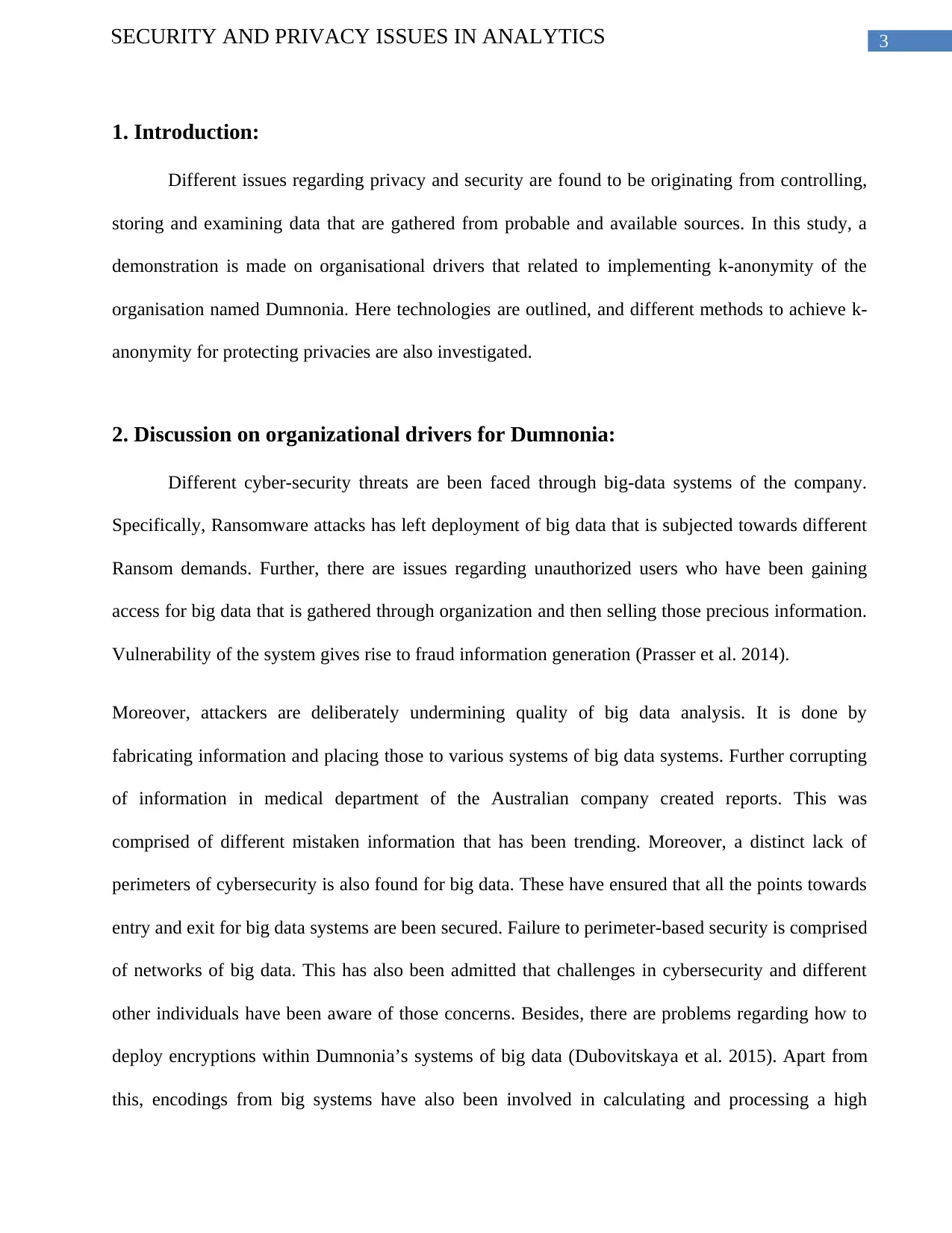
3SECURITY AND PRIVACY ISSUES IN ANALYTICS
1. Introduction:
Different issues regarding privacy and security are found to be originating from controlling,
storing and examining data that are gathered from probable and available sources. In this study, a
demonstration is made on organisational drivers that related to implementing k-anonymity of the
organisation named Dumnonia. Here technologies are outlined, and different methods to achieve k-
anonymity for protecting privacies are also investigated.
2. Discussion on organizational drivers for Dumnonia:
Different cyber-security threats are been faced through big-data systems of the company.
Specifically, Ransomware attacks has left deployment of big data that is subjected towards different
Ransom demands. Further, there are issues regarding unauthorized users who have been gaining
access for big data that is gathered through organization and then selling those precious information.
Vulnerability of the system gives rise to fraud information generation (Prasser et al. 2014).
Moreover, attackers are deliberately undermining quality of big data analysis. It is done by
fabricating information and placing those to various systems of big data systems. Further corrupting
of information in medical department of the Australian company created reports. This was
comprised of different mistaken information that has been trending. Moreover, a distinct lack of
perimeters of cybersecurity is also found for big data. These have ensured that all the points towards
entry and exit for big data systems are been secured. Failure to perimeter-based security is comprised
of networks of big data. This has also been admitted that challenges in cybersecurity and different
other individuals have been aware of those concerns. Besides, there are problems regarding how to
deploy encryptions within Dumnonia’s systems of big data (Dubovitskaya et al. 2015). Apart from
this, encodings from big systems have also been involved in calculating and processing a high
1. Introduction:
Different issues regarding privacy and security are found to be originating from controlling,
storing and examining data that are gathered from probable and available sources. In this study, a
demonstration is made on organisational drivers that related to implementing k-anonymity of the
organisation named Dumnonia. Here technologies are outlined, and different methods to achieve k-
anonymity for protecting privacies are also investigated.
2. Discussion on organizational drivers for Dumnonia:
Different cyber-security threats are been faced through big-data systems of the company.
Specifically, Ransomware attacks has left deployment of big data that is subjected towards different
Ransom demands. Further, there are issues regarding unauthorized users who have been gaining
access for big data that is gathered through organization and then selling those precious information.
Vulnerability of the system gives rise to fraud information generation (Prasser et al. 2014).
Moreover, attackers are deliberately undermining quality of big data analysis. It is done by
fabricating information and placing those to various systems of big data systems. Further corrupting
of information in medical department of the Australian company created reports. This was
comprised of different mistaken information that has been trending. Moreover, a distinct lack of
perimeters of cybersecurity is also found for big data. These have ensured that all the points towards
entry and exit for big data systems are been secured. Failure to perimeter-based security is comprised
of networks of big data. This has also been admitted that challenges in cybersecurity and different
other individuals have been aware of those concerns. Besides, there are problems regarding how to
deploy encryptions within Dumnonia’s systems of big data (Dubovitskaya et al. 2015). Apart from
this, encodings from big systems have also been involved in calculating and processing a high
Paraphrase This Document
Need a fresh take? Get an instant paraphrase of this document with our AI Paraphraser
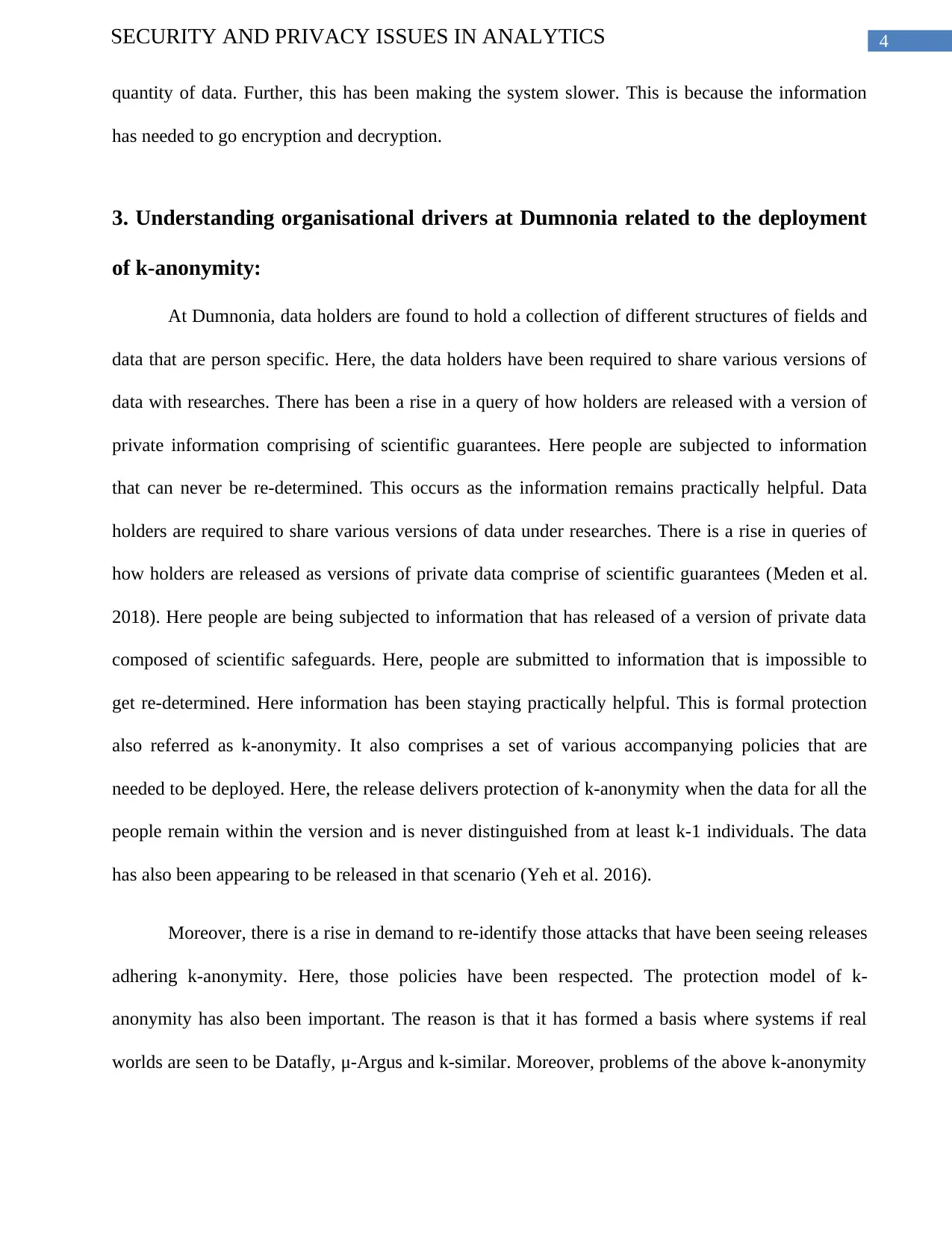
4SECURITY AND PRIVACY ISSUES IN ANALYTICS
quantity of data. Further, this has been making the system slower. This is because the information
has needed to go encryption and decryption.
3. Understanding organisational drivers at Dumnonia related to the deployment
of k-anonymity:
At Dumnonia, data holders are found to hold a collection of different structures of fields and
data that are person specific. Here, the data holders have been required to share various versions of
data with researches. There has been a rise in a query of how holders are released with a version of
private information comprising of scientific guarantees. Here people are subjected to information
that can never be re-determined. This occurs as the information remains practically helpful. Data
holders are required to share various versions of data under researches. There is a rise in queries of
how holders are released as versions of private data comprise of scientific guarantees (Meden et al.
2018). Here people are being subjected to information that has released of a version of private data
composed of scientific safeguards. Here, people are submitted to information that is impossible to
get re-determined. Here information has been staying practically helpful. This is formal protection
also referred as k-anonymity. It also comprises a set of various accompanying policies that are
needed to be deployed. Here, the release delivers protection of k-anonymity when the data for all the
people remain within the version and is never distinguished from at least k-1 individuals. The data
has also been appearing to be released in that scenario (Yeh et al. 2016).
Moreover, there is a rise in demand to re-identify those attacks that have been seeing releases
adhering k-anonymity. Here, those policies have been respected. The protection model of k-
anonymity has also been important. The reason is that it has formed a basis where systems if real
worlds are seen to be Datafly, μ-Argus and k-similar. Moreover, problems of the above k-anonymity
quantity of data. Further, this has been making the system slower. This is because the information
has needed to go encryption and decryption.
3. Understanding organisational drivers at Dumnonia related to the deployment
of k-anonymity:
At Dumnonia, data holders are found to hold a collection of different structures of fields and
data that are person specific. Here, the data holders have been required to share various versions of
data with researches. There has been a rise in a query of how holders are released with a version of
private information comprising of scientific guarantees. Here people are subjected to information
that can never be re-determined. This occurs as the information remains practically helpful. Data
holders are required to share various versions of data under researches. There is a rise in queries of
how holders are released as versions of private data comprise of scientific guarantees (Meden et al.
2018). Here people are being subjected to information that has released of a version of private data
composed of scientific safeguards. Here, people are submitted to information that is impossible to
get re-determined. Here information has been staying practically helpful. This is formal protection
also referred as k-anonymity. It also comprises a set of various accompanying policies that are
needed to be deployed. Here, the release delivers protection of k-anonymity when the data for all the
people remain within the version and is never distinguished from at least k-1 individuals. The data
has also been appearing to be released in that scenario (Yeh et al. 2016).
Moreover, there is a rise in demand to re-identify those attacks that have been seeing releases
adhering k-anonymity. Here, those policies have been respected. The protection model of k-
anonymity has also been important. The reason is that it has formed a basis where systems if real
worlds are seen to be Datafly, μ-Argus and k-similar. Moreover, problems of the above k-anonymity
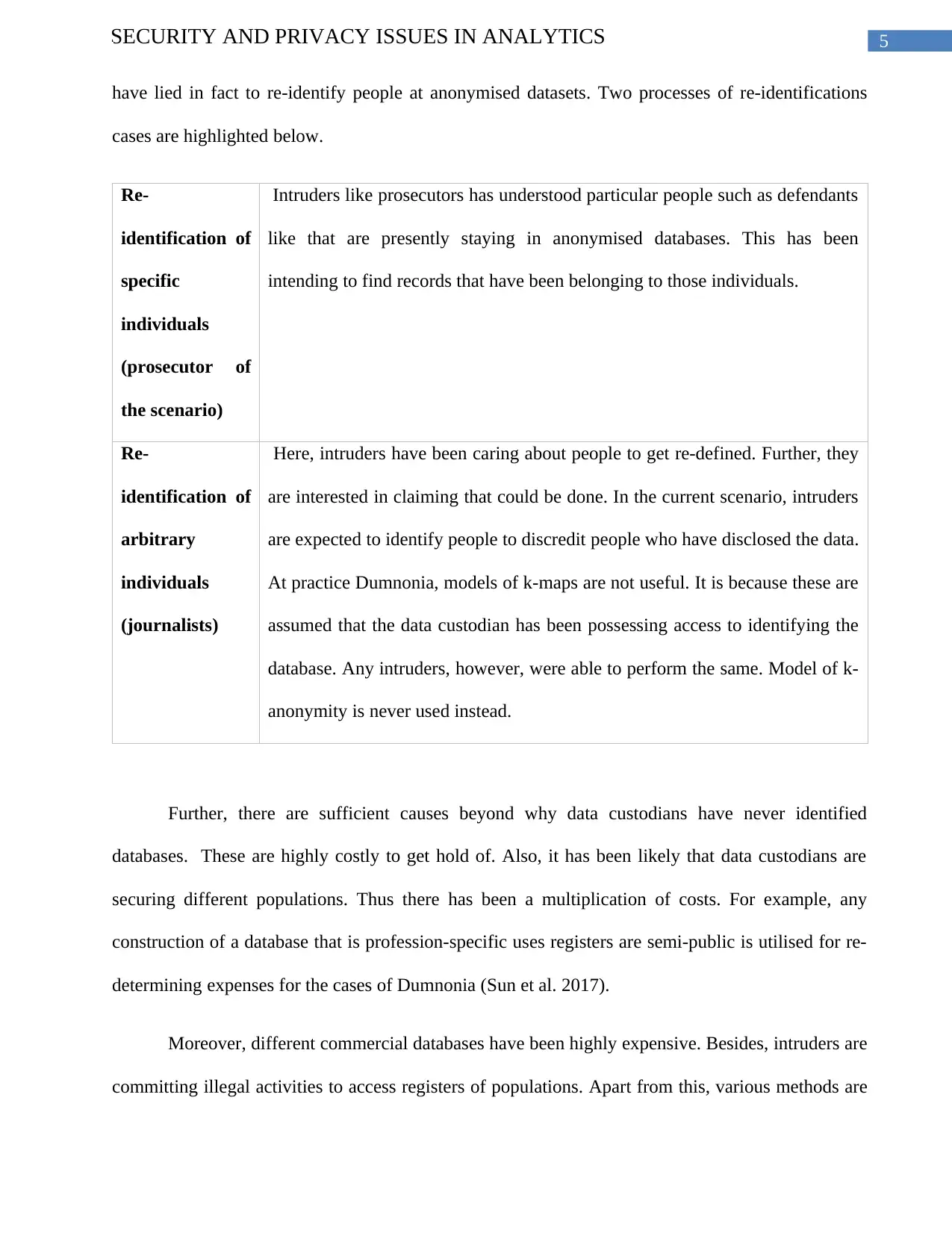
5SECURITY AND PRIVACY ISSUES IN ANALYTICS
have lied in fact to re-identify people at anonymised datasets. Two processes of re-identifications
cases are highlighted below.
Re-
identification of
specific
individuals
(prosecutor of
the scenario)
Intruders like prosecutors has understood particular people such as defendants
like that are presently staying in anonymised databases. This has been
intending to find records that have been belonging to those individuals.
Re-
identification of
arbitrary
individuals
(journalists)
Here, intruders have been caring about people to get re-defined. Further, they
are interested in claiming that could be done. In the current scenario, intruders
are expected to identify people to discredit people who have disclosed the data.
At practice Dumnonia, models of k-maps are not useful. It is because these are
assumed that the data custodian has been possessing access to identifying the
database. Any intruders, however, were able to perform the same. Model of k-
anonymity is never used instead.
Further, there are sufficient causes beyond why data custodians have never identified
databases. These are highly costly to get hold of. Also, it has been likely that data custodians are
securing different populations. Thus there has been a multiplication of costs. For example, any
construction of a database that is profession-specific uses registers are semi-public is utilised for re-
determining expenses for the cases of Dumnonia (Sun et al. 2017).
Moreover, different commercial databases have been highly expensive. Besides, intruders are
committing illegal activities to access registers of populations. Apart from this, various methods are
have lied in fact to re-identify people at anonymised datasets. Two processes of re-identifications
cases are highlighted below.
Re-
identification of
specific
individuals
(prosecutor of
the scenario)
Intruders like prosecutors has understood particular people such as defendants
like that are presently staying in anonymised databases. This has been
intending to find records that have been belonging to those individuals.
Re-
identification of
arbitrary
individuals
(journalists)
Here, intruders have been caring about people to get re-defined. Further, they
are interested in claiming that could be done. In the current scenario, intruders
are expected to identify people to discredit people who have disclosed the data.
At practice Dumnonia, models of k-maps are not useful. It is because these are
assumed that the data custodian has been possessing access to identifying the
database. Any intruders, however, were able to perform the same. Model of k-
anonymity is never used instead.
Further, there are sufficient causes beyond why data custodians have never identified
databases. These are highly costly to get hold of. Also, it has been likely that data custodians are
securing different populations. Thus there has been a multiplication of costs. For example, any
construction of a database that is profession-specific uses registers are semi-public is utilised for re-
determining expenses for the cases of Dumnonia (Sun et al. 2017).
Moreover, different commercial databases have been highly expensive. Besides, intruders are
committing illegal activities to access registers of populations. Apart from this, various methods are
⊘ This is a preview!⊘
Do you want full access?
Subscribe today to unlock all pages.

Trusted by 1+ million students worldwide
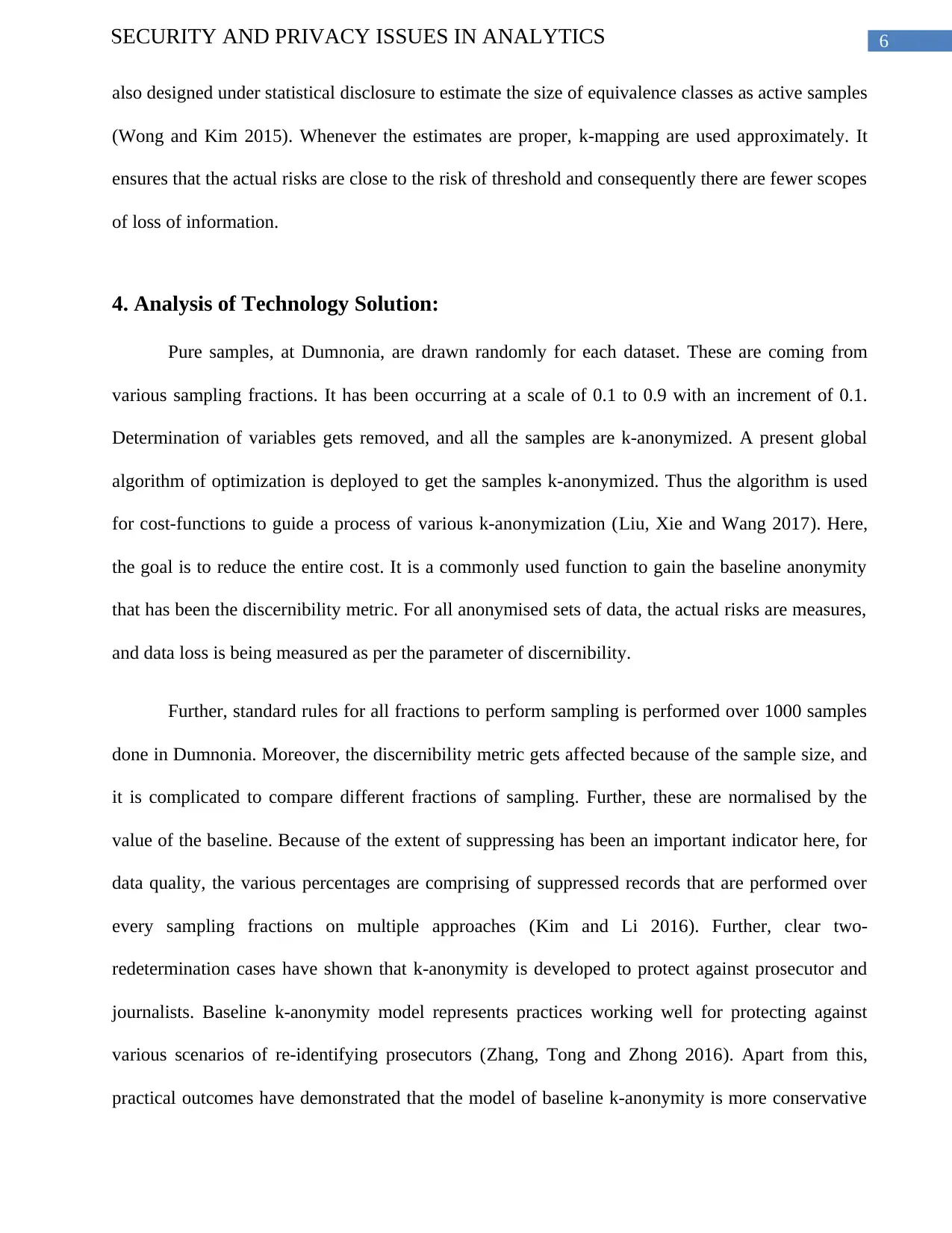
6SECURITY AND PRIVACY ISSUES IN ANALYTICS
also designed under statistical disclosure to estimate the size of equivalence classes as active samples
(Wong and Kim 2015). Whenever the estimates are proper, k-mapping are used approximately. It
ensures that the actual risks are close to the risk of threshold and consequently there are fewer scopes
of loss of information.
4. Analysis of Technology Solution:
Pure samples, at Dumnonia, are drawn randomly for each dataset. These are coming from
various sampling fractions. It has been occurring at a scale of 0.1 to 0.9 with an increment of 0.1.
Determination of variables gets removed, and all the samples are k-anonymized. A present global
algorithm of optimization is deployed to get the samples k-anonymized. Thus the algorithm is used
for cost-functions to guide a process of various k-anonymization (Liu, Xie and Wang 2017). Here,
the goal is to reduce the entire cost. It is a commonly used function to gain the baseline anonymity
that has been the discernibility metric. For all anonymised sets of data, the actual risks are measures,
and data loss is being measured as per the parameter of discernibility.
Further, standard rules for all fractions to perform sampling is performed over 1000 samples
done in Dumnonia. Moreover, the discernibility metric gets affected because of the sample size, and
it is complicated to compare different fractions of sampling. Further, these are normalised by the
value of the baseline. Because of the extent of suppressing has been an important indicator here, for
data quality, the various percentages are comprising of suppressed records that are performed over
every sampling fractions on multiple approaches (Kim and Li 2016). Further, clear two-
redetermination cases have shown that k-anonymity is developed to protect against prosecutor and
journalists. Baseline k-anonymity model represents practices working well for protecting against
various scenarios of re-identifying prosecutors (Zhang, Tong and Zhong 2016). Apart from this,
practical outcomes have demonstrated that the model of baseline k-anonymity is more conservative
also designed under statistical disclosure to estimate the size of equivalence classes as active samples
(Wong and Kim 2015). Whenever the estimates are proper, k-mapping are used approximately. It
ensures that the actual risks are close to the risk of threshold and consequently there are fewer scopes
of loss of information.
4. Analysis of Technology Solution:
Pure samples, at Dumnonia, are drawn randomly for each dataset. These are coming from
various sampling fractions. It has been occurring at a scale of 0.1 to 0.9 with an increment of 0.1.
Determination of variables gets removed, and all the samples are k-anonymized. A present global
algorithm of optimization is deployed to get the samples k-anonymized. Thus the algorithm is used
for cost-functions to guide a process of various k-anonymization (Liu, Xie and Wang 2017). Here,
the goal is to reduce the entire cost. It is a commonly used function to gain the baseline anonymity
that has been the discernibility metric. For all anonymised sets of data, the actual risks are measures,
and data loss is being measured as per the parameter of discernibility.
Further, standard rules for all fractions to perform sampling is performed over 1000 samples
done in Dumnonia. Moreover, the discernibility metric gets affected because of the sample size, and
it is complicated to compare different fractions of sampling. Further, these are normalised by the
value of the baseline. Because of the extent of suppressing has been an important indicator here, for
data quality, the various percentages are comprising of suppressed records that are performed over
every sampling fractions on multiple approaches (Kim and Li 2016). Further, clear two-
redetermination cases have shown that k-anonymity is developed to protect against prosecutor and
journalists. Baseline k-anonymity model represents practices working well for protecting against
various scenarios of re-identifying prosecutors (Zhang, Tong and Zhong 2016). Apart from this,
practical outcomes have demonstrated that the model of baseline k-anonymity is more conservative
Paraphrase This Document
Need a fresh take? Get an instant paraphrase of this document with our AI Paraphraser
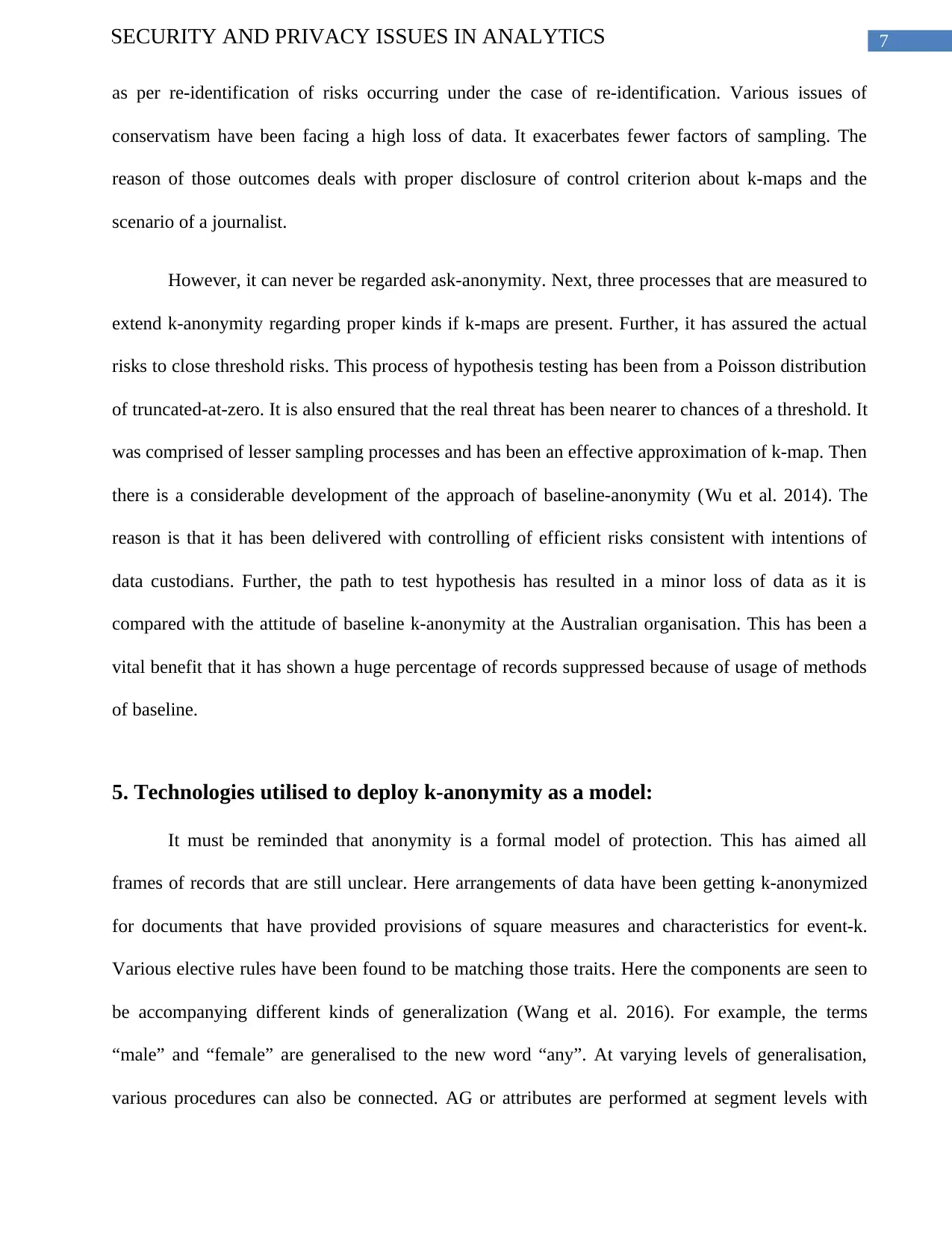
7SECURITY AND PRIVACY ISSUES IN ANALYTICS
as per re-identification of risks occurring under the case of re-identification. Various issues of
conservatism have been facing a high loss of data. It exacerbates fewer factors of sampling. The
reason of those outcomes deals with proper disclosure of control criterion about k-maps and the
scenario of a journalist.
However, it can never be regarded ask-anonymity. Next, three processes that are measured to
extend k-anonymity regarding proper kinds if k-maps are present. Further, it has assured the actual
risks to close threshold risks. This process of hypothesis testing has been from a Poisson distribution
of truncated-at-zero. It is also ensured that the real threat has been nearer to chances of a threshold. It
was comprised of lesser sampling processes and has been an effective approximation of k-map. Then
there is a considerable development of the approach of baseline-anonymity (Wu et al. 2014). The
reason is that it has been delivered with controlling of efficient risks consistent with intentions of
data custodians. Further, the path to test hypothesis has resulted in a minor loss of data as it is
compared with the attitude of baseline k-anonymity at the Australian organisation. This has been a
vital benefit that it has shown a huge percentage of records suppressed because of usage of methods
of baseline.
5. Technologies utilised to deploy k-anonymity as a model:
It must be reminded that anonymity is a formal model of protection. This has aimed all
frames of records that are still unclear. Here arrangements of data have been getting k-anonymized
for documents that have provided provisions of square measures and characteristics for event-k.
Various elective rules have been found to be matching those traits. Here the components are seen to
be accompanying different kinds of generalization (Wang et al. 2016). For example, the terms
“male” and “female” are generalised to the new word “any”. At varying levels of generalisation,
various procedures can also be connected. AG or attributes are performed at segment levels with
as per re-identification of risks occurring under the case of re-identification. Various issues of
conservatism have been facing a high loss of data. It exacerbates fewer factors of sampling. The
reason of those outcomes deals with proper disclosure of control criterion about k-maps and the
scenario of a journalist.
However, it can never be regarded ask-anonymity. Next, three processes that are measured to
extend k-anonymity regarding proper kinds if k-maps are present. Further, it has assured the actual
risks to close threshold risks. This process of hypothesis testing has been from a Poisson distribution
of truncated-at-zero. It is also ensured that the real threat has been nearer to chances of a threshold. It
was comprised of lesser sampling processes and has been an effective approximation of k-map. Then
there is a considerable development of the approach of baseline-anonymity (Wu et al. 2014). The
reason is that it has been delivered with controlling of efficient risks consistent with intentions of
data custodians. Further, the path to test hypothesis has resulted in a minor loss of data as it is
compared with the attitude of baseline k-anonymity at the Australian organisation. This has been a
vital benefit that it has shown a huge percentage of records suppressed because of usage of methods
of baseline.
5. Technologies utilised to deploy k-anonymity as a model:
It must be reminded that anonymity is a formal model of protection. This has aimed all
frames of records that are still unclear. Here arrangements of data have been getting k-anonymized
for documents that have provided provisions of square measures and characteristics for event-k.
Various elective rules have been found to be matching those traits. Here the components are seen to
be accompanying different kinds of generalization (Wang et al. 2016). For example, the terms
“male” and “female” are generalised to the new word “any”. At varying levels of generalisation,
various procedures can also be connected. AG or attributes are performed at segment levels with
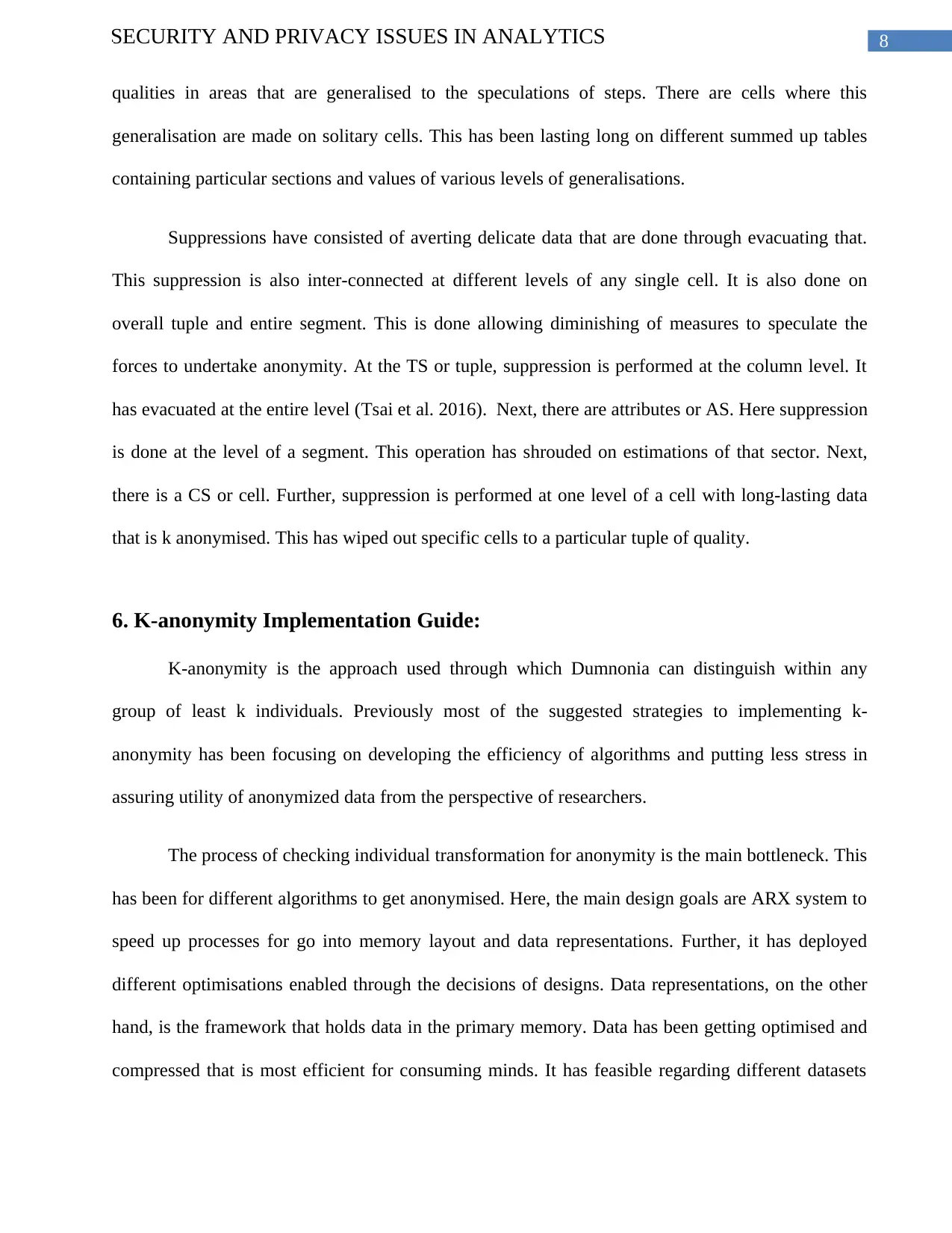
8SECURITY AND PRIVACY ISSUES IN ANALYTICS
qualities in areas that are generalised to the speculations of steps. There are cells where this
generalisation are made on solitary cells. This has been lasting long on different summed up tables
containing particular sections and values of various levels of generalisations.
Suppressions have consisted of averting delicate data that are done through evacuating that.
This suppression is also inter-connected at different levels of any single cell. It is also done on
overall tuple and entire segment. This is done allowing diminishing of measures to speculate the
forces to undertake anonymity. At the TS or tuple, suppression is performed at the column level. It
has evacuated at the entire level (Tsai et al. 2016). Next, there are attributes or AS. Here suppression
is done at the level of a segment. This operation has shrouded on estimations of that sector. Next,
there is a CS or cell. Further, suppression is performed at one level of a cell with long-lasting data
that is k anonymised. This has wiped out specific cells to a particular tuple of quality.
6. K-anonymity Implementation Guide:
K-anonymity is the approach used through which Dumnonia can distinguish within any
group of least k individuals. Previously most of the suggested strategies to implementing k-
anonymity has been focusing on developing the efficiency of algorithms and putting less stress in
assuring utility of anonymized data from the perspective of researchers.
The process of checking individual transformation for anonymity is the main bottleneck. This
has been for different algorithms to get anonymised. Here, the main design goals are ARX system to
speed up processes for go into memory layout and data representations. Further, it has deployed
different optimisations enabled through the decisions of designs. Data representations, on the other
hand, is the framework that holds data in the primary memory. Data has been getting optimised and
compressed that is most efficient for consuming minds. It has feasible regarding different datasets
qualities in areas that are generalised to the speculations of steps. There are cells where this
generalisation are made on solitary cells. This has been lasting long on different summed up tables
containing particular sections and values of various levels of generalisations.
Suppressions have consisted of averting delicate data that are done through evacuating that.
This suppression is also inter-connected at different levels of any single cell. It is also done on
overall tuple and entire segment. This is done allowing diminishing of measures to speculate the
forces to undertake anonymity. At the TS or tuple, suppression is performed at the column level. It
has evacuated at the entire level (Tsai et al. 2016). Next, there are attributes or AS. Here suppression
is done at the level of a segment. This operation has shrouded on estimations of that sector. Next,
there is a CS or cell. Further, suppression is performed at one level of a cell with long-lasting data
that is k anonymised. This has wiped out specific cells to a particular tuple of quality.
6. K-anonymity Implementation Guide:
K-anonymity is the approach used through which Dumnonia can distinguish within any
group of least k individuals. Previously most of the suggested strategies to implementing k-
anonymity has been focusing on developing the efficiency of algorithms and putting less stress in
assuring utility of anonymized data from the perspective of researchers.
The process of checking individual transformation for anonymity is the main bottleneck. This
has been for different algorithms to get anonymised. Here, the main design goals are ARX system to
speed up processes for go into memory layout and data representations. Further, it has deployed
different optimisations enabled through the decisions of designs. Data representations, on the other
hand, is the framework that holds data in the primary memory. Data has been getting optimised and
compressed that is most efficient for consuming minds. It has feasible regarding different datasets
⊘ This is a preview!⊘
Do you want full access?
Subscribe today to unlock all pages.

Trusted by 1+ million students worldwide
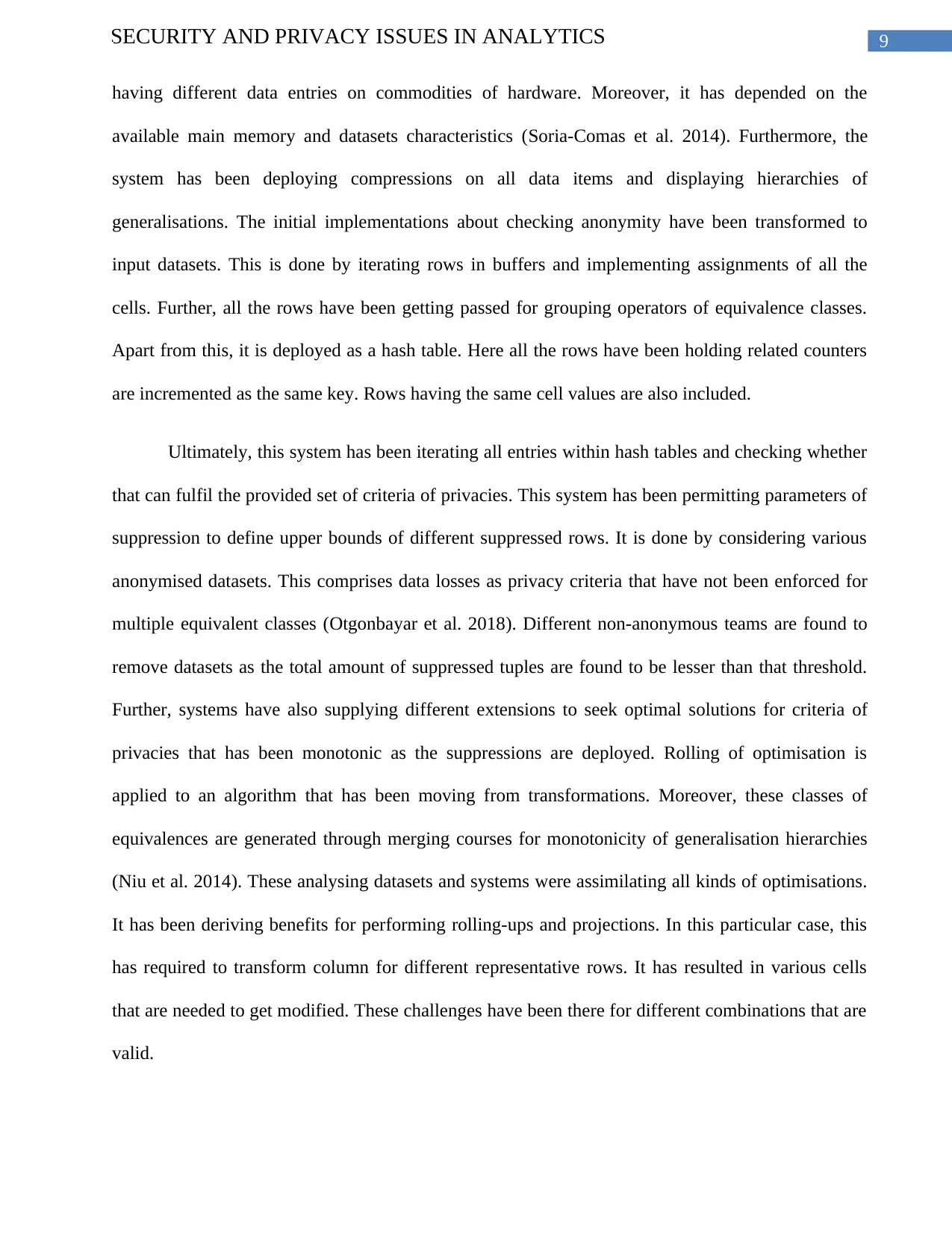
9SECURITY AND PRIVACY ISSUES IN ANALYTICS
having different data entries on commodities of hardware. Moreover, it has depended on the
available main memory and datasets characteristics (Soria-Comas et al. 2014). Furthermore, the
system has been deploying compressions on all data items and displaying hierarchies of
generalisations. The initial implementations about checking anonymity have been transformed to
input datasets. This is done by iterating rows in buffers and implementing assignments of all the
cells. Further, all the rows have been getting passed for grouping operators of equivalence classes.
Apart from this, it is deployed as a hash table. Here all the rows have been holding related counters
are incremented as the same key. Rows having the same cell values are also included.
Ultimately, this system has been iterating all entries within hash tables and checking whether
that can fulfil the provided set of criteria of privacies. This system has been permitting parameters of
suppression to define upper bounds of different suppressed rows. It is done by considering various
anonymised datasets. This comprises data losses as privacy criteria that have not been enforced for
multiple equivalent classes (Otgonbayar et al. 2018). Different non-anonymous teams are found to
remove datasets as the total amount of suppressed tuples are found to be lesser than that threshold.
Further, systems have also supplying different extensions to seek optimal solutions for criteria of
privacies that has been monotonic as the suppressions are deployed. Rolling of optimisation is
applied to an algorithm that has been moving from transformations. Moreover, these classes of
equivalences are generated through merging courses for monotonicity of generalisation hierarchies
(Niu et al. 2014). These analysing datasets and systems were assimilating all kinds of optimisations.
It has been deriving benefits for performing rolling-ups and projections. In this particular case, this
has required to transform column for different representative rows. It has resulted in various cells
that are needed to get modified. These challenges have been there for different combinations that are
valid.
having different data entries on commodities of hardware. Moreover, it has depended on the
available main memory and datasets characteristics (Soria-Comas et al. 2014). Furthermore, the
system has been deploying compressions on all data items and displaying hierarchies of
generalisations. The initial implementations about checking anonymity have been transformed to
input datasets. This is done by iterating rows in buffers and implementing assignments of all the
cells. Further, all the rows have been getting passed for grouping operators of equivalence classes.
Apart from this, it is deployed as a hash table. Here all the rows have been holding related counters
are incremented as the same key. Rows having the same cell values are also included.
Ultimately, this system has been iterating all entries within hash tables and checking whether
that can fulfil the provided set of criteria of privacies. This system has been permitting parameters of
suppression to define upper bounds of different suppressed rows. It is done by considering various
anonymised datasets. This comprises data losses as privacy criteria that have not been enforced for
multiple equivalent classes (Otgonbayar et al. 2018). Different non-anonymous teams are found to
remove datasets as the total amount of suppressed tuples are found to be lesser than that threshold.
Further, systems have also supplying different extensions to seek optimal solutions for criteria of
privacies that has been monotonic as the suppressions are deployed. Rolling of optimisation is
applied to an algorithm that has been moving from transformations. Moreover, these classes of
equivalences are generated through merging courses for monotonicity of generalisation hierarchies
(Niu et al. 2014). These analysing datasets and systems were assimilating all kinds of optimisations.
It has been deriving benefits for performing rolling-ups and projections. In this particular case, this
has required to transform column for different representative rows. It has resulted in various cells
that are needed to get modified. These challenges have been there for different combinations that are
valid.
Paraphrase This Document
Need a fresh take? Get an instant paraphrase of this document with our AI Paraphraser
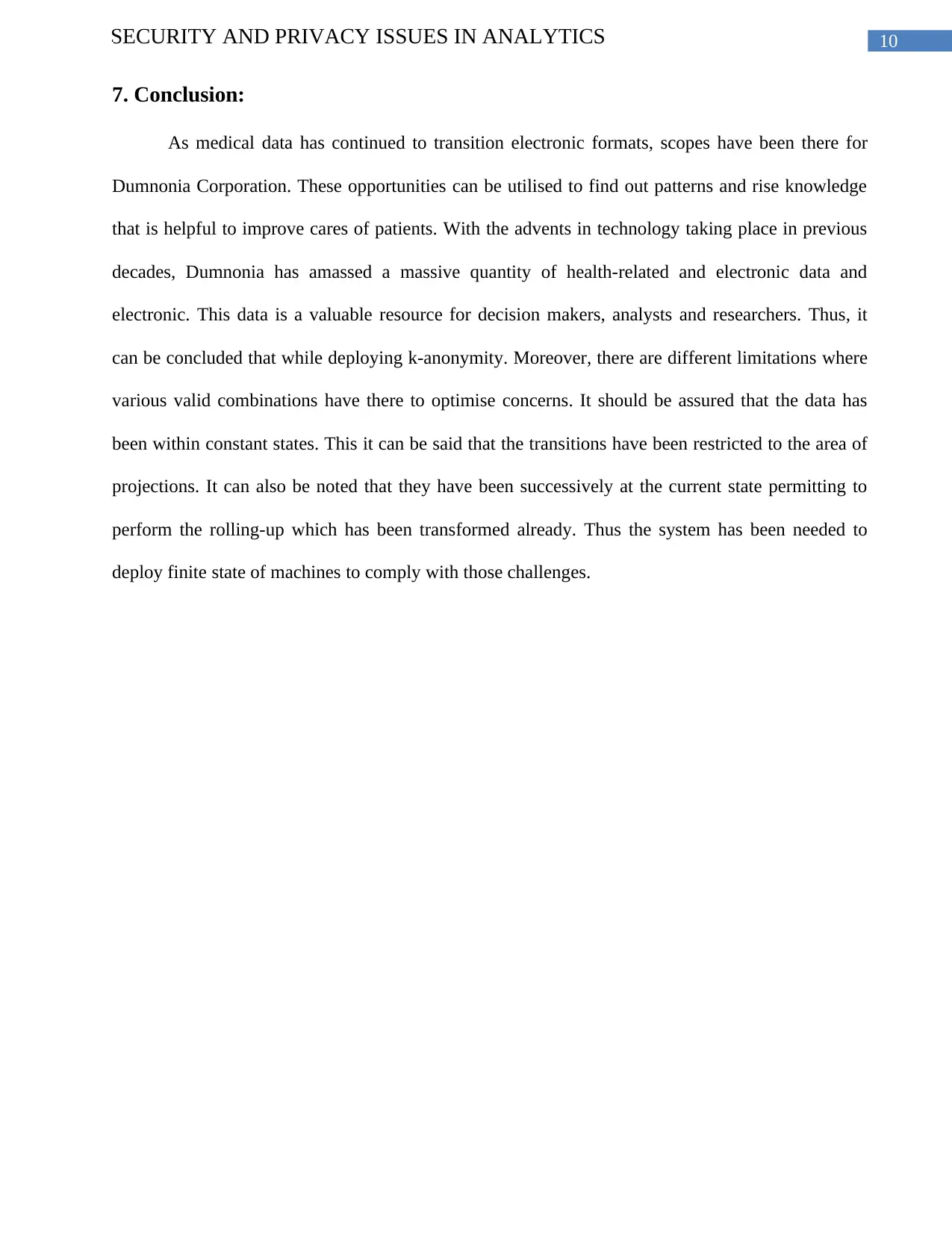
10SECURITY AND PRIVACY ISSUES IN ANALYTICS
7. Conclusion:
As medical data has continued to transition electronic formats, scopes have been there for
Dumnonia Corporation. These opportunities can be utilised to find out patterns and rise knowledge
that is helpful to improve cares of patients. With the advents in technology taking place in previous
decades, Dumnonia has amassed a massive quantity of health-related and electronic data and
electronic. This data is a valuable resource for decision makers, analysts and researchers. Thus, it
can be concluded that while deploying k-anonymity. Moreover, there are different limitations where
various valid combinations have there to optimise concerns. It should be assured that the data has
been within constant states. This it can be said that the transitions have been restricted to the area of
projections. It can also be noted that they have been successively at the current state permitting to
perform the rolling-up which has been transformed already. Thus the system has been needed to
deploy finite state of machines to comply with those challenges.
7. Conclusion:
As medical data has continued to transition electronic formats, scopes have been there for
Dumnonia Corporation. These opportunities can be utilised to find out patterns and rise knowledge
that is helpful to improve cares of patients. With the advents in technology taking place in previous
decades, Dumnonia has amassed a massive quantity of health-related and electronic data and
electronic. This data is a valuable resource for decision makers, analysts and researchers. Thus, it
can be concluded that while deploying k-anonymity. Moreover, there are different limitations where
various valid combinations have there to optimise concerns. It should be assured that the data has
been within constant states. This it can be said that the transitions have been restricted to the area of
projections. It can also be noted that they have been successively at the current state permitting to
perform the rolling-up which has been transformed already. Thus the system has been needed to
deploy finite state of machines to comply with those challenges.
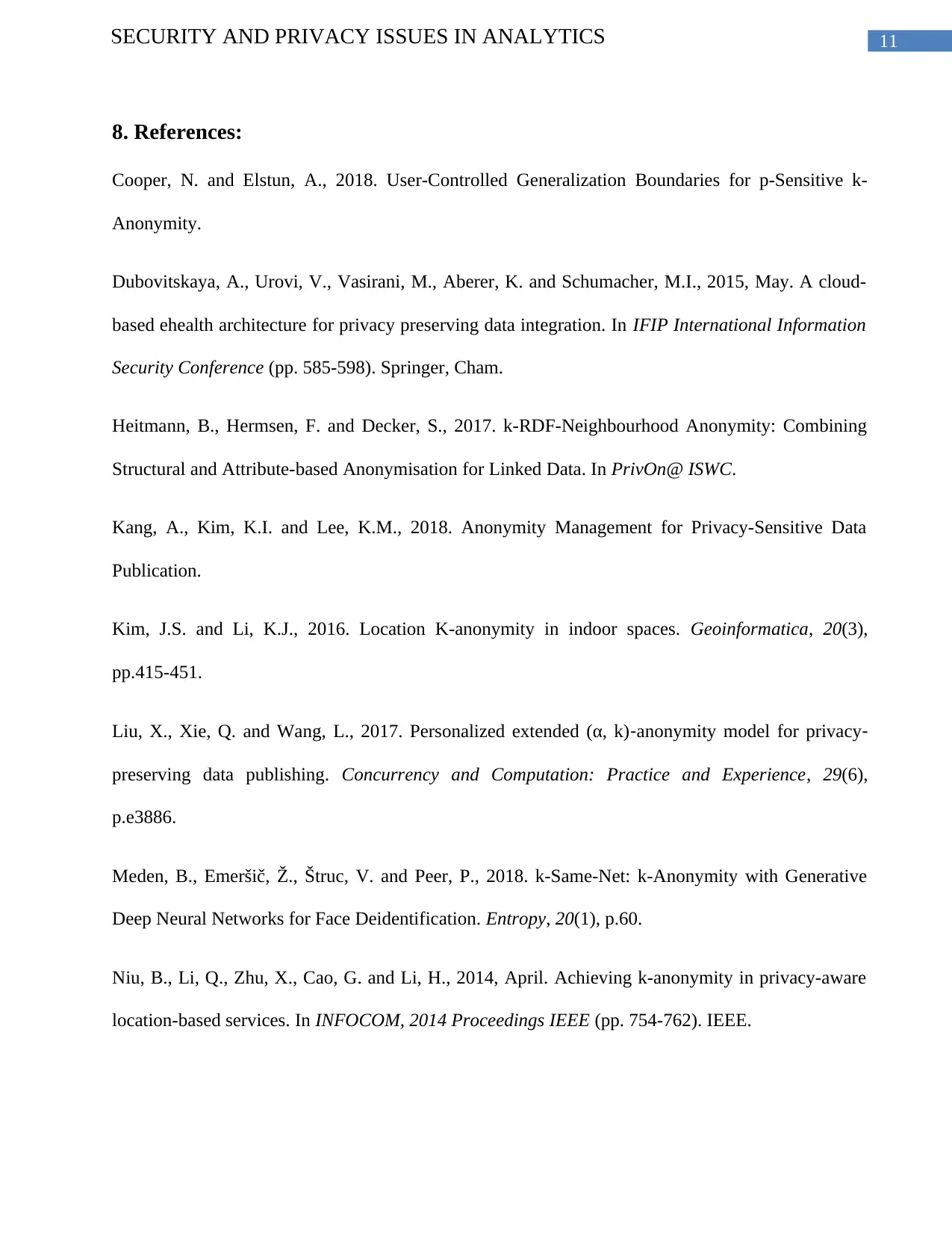
11SECURITY AND PRIVACY ISSUES IN ANALYTICS
8. References:
Cooper, N. and Elstun, A., 2018. User-Controlled Generalization Boundaries for p-Sensitive k-
Anonymity.
Dubovitskaya, A., Urovi, V., Vasirani, M., Aberer, K. and Schumacher, M.I., 2015, May. A cloud-
based ehealth architecture for privacy preserving data integration. In IFIP International Information
Security Conference (pp. 585-598). Springer, Cham.
Heitmann, B., Hermsen, F. and Decker, S., 2017. k-RDF-Neighbourhood Anonymity: Combining
Structural and Attribute-based Anonymisation for Linked Data. In PrivOn@ ISWC.
Kang, A., Kim, K.I. and Lee, K.M., 2018. Anonymity Management for Privacy-Sensitive Data
Publication.
Kim, J.S. and Li, K.J., 2016. Location K-anonymity in indoor spaces. Geoinformatica, 20(3),
pp.415-451.
Liu, X., Xie, Q. and Wang, L., 2017. Personalized extended (α, k)‐anonymity model for privacy‐
preserving data publishing. Concurrency and Computation: Practice and Experience, 29(6),
p.e3886.
Meden, B., Emeršič, Ž., Štruc, V. and Peer, P., 2018. k-Same-Net: k-Anonymity with Generative
Deep Neural Networks for Face Deidentification. Entropy, 20(1), p.60.
Niu, B., Li, Q., Zhu, X., Cao, G. and Li, H., 2014, April. Achieving k-anonymity in privacy-aware
location-based services. In INFOCOM, 2014 Proceedings IEEE (pp. 754-762). IEEE.
8. References:
Cooper, N. and Elstun, A., 2018. User-Controlled Generalization Boundaries for p-Sensitive k-
Anonymity.
Dubovitskaya, A., Urovi, V., Vasirani, M., Aberer, K. and Schumacher, M.I., 2015, May. A cloud-
based ehealth architecture for privacy preserving data integration. In IFIP International Information
Security Conference (pp. 585-598). Springer, Cham.
Heitmann, B., Hermsen, F. and Decker, S., 2017. k-RDF-Neighbourhood Anonymity: Combining
Structural and Attribute-based Anonymisation for Linked Data. In PrivOn@ ISWC.
Kang, A., Kim, K.I. and Lee, K.M., 2018. Anonymity Management for Privacy-Sensitive Data
Publication.
Kim, J.S. and Li, K.J., 2016. Location K-anonymity in indoor spaces. Geoinformatica, 20(3),
pp.415-451.
Liu, X., Xie, Q. and Wang, L., 2017. Personalized extended (α, k)‐anonymity model for privacy‐
preserving data publishing. Concurrency and Computation: Practice and Experience, 29(6),
p.e3886.
Meden, B., Emeršič, Ž., Štruc, V. and Peer, P., 2018. k-Same-Net: k-Anonymity with Generative
Deep Neural Networks for Face Deidentification. Entropy, 20(1), p.60.
Niu, B., Li, Q., Zhu, X., Cao, G. and Li, H., 2014, April. Achieving k-anonymity in privacy-aware
location-based services. In INFOCOM, 2014 Proceedings IEEE (pp. 754-762). IEEE.
⊘ This is a preview!⊘
Do you want full access?
Subscribe today to unlock all pages.

Trusted by 1+ million students worldwide
1 out of 14
Related Documents
Your All-in-One AI-Powered Toolkit for Academic Success.
+13062052269
info@desklib.com
Available 24*7 on WhatsApp / Email
![[object Object]](/_next/static/media/star-bottom.7253800d.svg)
Unlock your academic potential
Copyright © 2020–2025 A2Z Services. All Rights Reserved. Developed and managed by ZUCOL.





